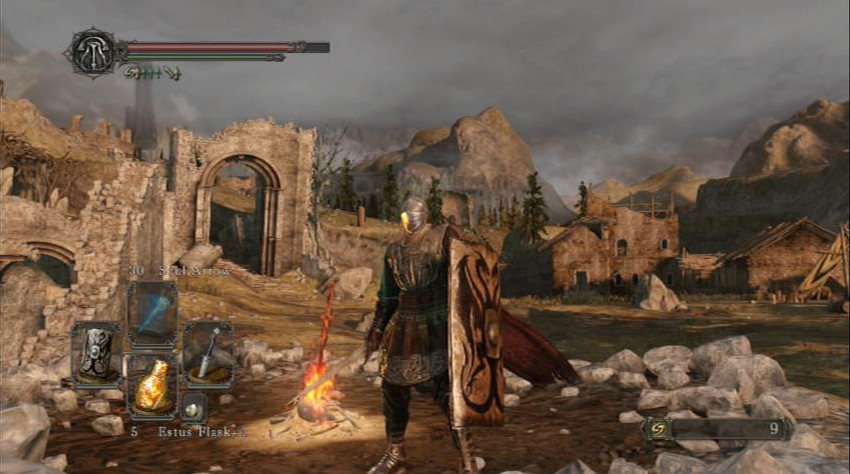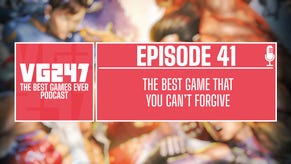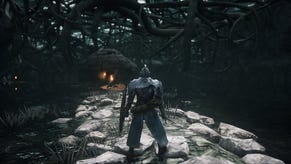Dark Souls 2 journal #1: the first ten hours have been painful
Dark Souls reviews have begun, and rather than try to sum up From Software's intricate and challenging RPG in one article, Dave Cook's doing an impressions-in-progress journal of his journey through the whole thing. He's nuts, clearly.
(Note: this is an impressions piece-in-progress, and our first entry covers the opening ten hours, up to level 45)
At the time of writing these words I'm now over ten hours into Dark Souls 2, my knight is level 45 and I've only just passed the second boss. I should be further, but since when was this series about speed-running?
To appraise From Software's RPG at speed would be to overlook some of its most-alluring aspects, such as drinking in its bleak atmosphere, searching every corner and trying to unlock the game's deepest secrets. Don't forget that gamers were still adding to the Dark Souls wiki guide well over a year after the game launched, and the realisation that the world's about to go through that analytical process again is both exciting and daunting.
We're not a review site, but I wanted to give you an accurate account of what Dark Souls 2 is like to play and absorb at a realistic pace, so I decided to take a journal approach where I chronicle my experience through the world of Drangleic, as well as explaining what works and what doesn't. As such; you should consider this article the first of several.
I knew from experience that both Dark and Demon's Souls are puzzles in themselves, and no quick review play-test was going to do the game credit, so I'll be as detailed as I can. As such; there may be some spoilers in here but I'll do my best to avoid them.
Prepare to go beyond death and venture onward, brave hero.
Scared New World
Characters and bosses aside, it could be argued that the main character of every Souls game are the worlds themselves. From the grand spires and towering cathedrals of Anor Londo, to the disease-ridden squalor of Blighttown, the depressing nature of these locales seeps through the screen, dragging you into a state of trepidation that refuses to let go. You'll plod onward over each miserable mile, fighting your own sense of apathy, refusing to admit defeat each time you die. It's miserable, and I love it.
Dark Souls 2's ruined kingdom of Drangleic is no different, and it starts off as it means to go on. After a rather superb cinematic, your hero emerges in a strange region called Things Betwixt and you're set upon by a gang of dog-like beasts after just a few moments. You don't even have a weapon at this point. After punching the bastards to death I marched forward and arrived at a house occupied by a group of cackling hags. They explain that you've been cursed somehow and that like all those who become afflicted, you're there to find the cure.
Many have tired and failed, and those who give up turn into mindless Hollows. They laugh a bit, explain that you're going to die often and off you trot to the first bonfire, ready to enter the realm of sadism and hard-fought victory once more. If you've played Dark Souls before, you'll relish the familiarity of it all, and it becomes clear that From Software hasn't ruined the template as many had feared.
That's not a typo. Dark Souls 2 doesn't let you sprint around the nearby area, kill everything for souls, then hit the reset button by visiting a bonfire over and over again. Each enemy stops re-appearing after a number of deaths - the actual amount is still uncertain - and this really p**sed me off at first. But after being forced to move on to another area I realised that From Software have been smart here. It stops the game from being a repetitive grind and forces you to tackle new challenges elsewhere. It also makes souls in one area a finite resource that you need to spend wisely, as if you weren't pressured enough.
So that's the big conundrum. Do you spend those souls on levelling, buying items or upgrading your gear, knowing that they'll run out soon enough? That's a new type of pressure that just mounts on all of the arduous elements thrown at you in the first game. I'm well past the ten hour mark as I write this, but even now those early enemies haven't respawned. They may have done by the time I write my next blog, but I'm yet to figure out how to make them return.
As grim as the world is, I have to admit that the first full area was a little brighter than I'd first anticipated, but then the death began...
Stab, Block, Die, Repeat
Your first port of call after Majula is The Valley of Fallen Giants, and it's a lush green forest that hides a crumbling and perilous castle. My first thought was that it was a little on the bright side for a Souls game, but rest assured, you'll start to feel grim after your first ten deaths, then utterly broken after the next 20. The problem, you see, is that every time you die the game knocks some of your maximum health off, up to 50 percent.
Again; that's not a typo. You actually lose some of your maximum vitality each time you keel over, and it can only be restored by consuming human effigies. The process is similar to reverse-Hollowing in Dark Souls, but this time you can do it anywhere. My recommendation is to only do this before bosses however, because while effigies can be bought you don't want to go wasting them on low-level areas and grunts. To avoid death you'll need a supply of Life Gems and Estus Flasks. You can earn more of the latter by bringing flask shards to the Majula maiden. She's brilliant.
Facing off against the valley's initial foes was a breeze, and that's purely because the Souls skill-set is transferable. If you've played any of these games you'll know that you can lock-on to a foe, circle it and trash out with your sword or let rip with magic. You can dodge roll, block and parry incoming blows like before, and chances are your first two or so hours will be a nice, gradual refresher course in how to fight. I quickly started grinding the opening zone with its babbling stream and stone tower to save up souls to spend on new gear. Well; that was until the Hollow troops stopped respawning, much to my dismay.
You're well-equipped for these battles from the start though, which is something of a small show of mercy from the developer. From Software has also given you an extra equipment slot on each hand. When I wrote this article I had three swords equipped to my right hand - one was a longer broadsword that had fire damage for when I wanted to keep my distance - and on the left I equipped my shield, bow and crossbow for defence and ranged encounters. It's nice to have more space to play with, and this certainly doesn't make the tougher enemies any easier to contend with. People have voiced concerns over From Software stating that Dark Souls 2 is more accessible, and that's true. It definitely doesn't mean 'easier.'
After entering the valley castle's claustrophobic corridors and ramparts I quickly got into that 'always-blocking' frame of mind as there are enemies playing dead and hiding around corners everywhere. Veterans will know what to look out for here, but newcomers could get blind-sided constantly. It's a place that feels massive and daunting at first, and as you progress you'll find a switch that opens up a significant shortcut. These moments still feel wonderful, like a huge weight has lifted off your shoulders. Then you remember that those new routes all lead to death.
Victory... Achieved?
One I opened the gate mentioned above, I took a lift down to the castle basement. That's where the game's first boss - The Last Giant - lives. Like Dark Soul's wolf guardian Sif, I felt really sorry for this guy as I lashed out at his withered stone legs. The guy has been trapped in his underground prison for goodness knows how long, with a set of iron shackles still attached to his scrawny appendages, and here I am: some dick with a sword just strolling in to murder him.
He moans and sweeps with his arms slowly, and only occasionally stomps the ground to crush you underfoot. I managed to defeat the guy first time as a melee-heavy Knight class, and I can only imagine it being much easier with magic or ranged attacks. You get 10,000 souls for the kill and a Soldier's Key for your trouble, so I went back to Majula, levelled up and bought the Elite Knight armour set that you've all seen in the Dark Souls 2 trailers by now. It's really good. I'd recommend buying it as early as possible.
So why, if everything was relatively easy until this point, had I played for ten hours and only just killed two bosses? After obtaining the soldier's key I became utterly lost, simply because I failed to spot one single door. You probably won't miss it. I was just being a blind dick. Well there's that, and I had real trouble with Dark Souls 2's second boss; The Pursuer, a giant floating knight with an armour set similar to Havel's in the first game, and a massive shield. I fought him on the castle roof countless times and got stomped mercilessly.
At first I thought, 'Hey I know how this works: I just need to level up a little more and bang! I'll batter the guy no problem.' So off I went levelling for a good few hours, watching as enemies stopped respawning, forcing me to look elsewhere for souls. After about six or seven hours I went back to fight The Pursuer and got killed again, and again and again.
S**t.
And that is exactly why Dark Souls 2 is a fine sequel to From Software's series. That balance of risk, reward and hard graft is still the game's life-blood. Without it, the experience wouldn't be so utterly engrossing as it is, and I'm praising the sun that this essence hasn't been lost during the change of directors at the studio.
After I caught my breath I restocked and healed myself before curling up on a nearby bird's nest on the roof, only to be grabbed by a giant eagle and flown to the next area: the giant; blue-tinged Old Bastille.
Check out what went down in my second journal tomorrow, March 12.
Disclosure: To assist in writing this article, Namco Bandai sent Dave a copy of Dark Souls 2 on PS3.

















